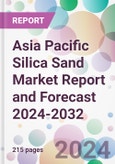According to the report, the Asia Pacific silica sand market is projected to grow at a CAGR of 6.8% between 2024 and 2032. Aided by the relentless demand from booming construction sectors and the burgeoning glass industry in major economies, the market is expected to grow significantly by 2032.
Silica sand, predominantly composed of silicon dioxide (SiO2), is one of the most widespread and accessible forms of sand on earth. In the Asia Pacific, its massive adoption is observed in industries ranging from glassmaking, foundry, construction to hydraulic fracturing. Owing to its purity, durability, and consistent grain size, silica sand has emerged as an indispensable component across diverse sectors.
Driving the Asia Pacific silica sand market growth is the relentless expansion of its construction industry. Nations such as China, India, and Indonesia are undergoing infrastructural metamorphoses, resulting in a skyrocketing demand for concrete and cement, where silica sand is a primary ingredient. This robust construction activity, coupled with the urbanisation trend in the region, ensures a persistent demand for silica sand.
Glass manufacturing is another stalwart of the Asia Pacific economy, particularly in China and India, which significantly relies on high-purity silica sand. From beverage bottles, automotive glass, to sophisticated electronics, the applications are vast and integral to modern life. The burgeoning growth of these industries directly translates into a heightened demand for silica sand in the region.
According to the Asia Pacific silica sand market analysis, the Asia Pacific boasts of a thriving automobile industry, and silica sand plays a pivotal role in the production of various auto parts. Its application extends to the making of moulds and cores for metal castings within the automotive industry.
Intricately linked to the digital revolution, the semiconductor industry is another prominent consumer of high-purity silica sand. Countries like Taiwan, South Korea, and China have established themselves as global hubs in semiconductor manufacturing, reinforcing the demand matrix for silica sand.
Furthermore, the cosmetics and personal care industry in the Asia Pacific, touted as one of the fastest-growing globally, relies heavily on silica sand. Leveraged for its exfoliating and absorbent properties, silica sand finds its place in various skincare and beauty products, influencing the Asia Pacific silica sand market outlook.
Silica sand, predominantly composed of silicon dioxide (SiO2), is one of the most widespread and accessible forms of sand on earth. In the Asia Pacific, its massive adoption is observed in industries ranging from glassmaking, foundry, construction to hydraulic fracturing. Owing to its purity, durability, and consistent grain size, silica sand has emerged as an indispensable component across diverse sectors.
Driving the Asia Pacific silica sand market growth is the relentless expansion of its construction industry. Nations such as China, India, and Indonesia are undergoing infrastructural metamorphoses, resulting in a skyrocketing demand for concrete and cement, where silica sand is a primary ingredient. This robust construction activity, coupled with the urbanisation trend in the region, ensures a persistent demand for silica sand.
Glass manufacturing is another stalwart of the Asia Pacific economy, particularly in China and India, which significantly relies on high-purity silica sand. From beverage bottles, automotive glass, to sophisticated electronics, the applications are vast and integral to modern life. The burgeoning growth of these industries directly translates into a heightened demand for silica sand in the region.
According to the Asia Pacific silica sand market analysis, the Asia Pacific boasts of a thriving automobile industry, and silica sand plays a pivotal role in the production of various auto parts. Its application extends to the making of moulds and cores for metal castings within the automotive industry.
Intricately linked to the digital revolution, the semiconductor industry is another prominent consumer of high-purity silica sand. Countries like Taiwan, South Korea, and China have established themselves as global hubs in semiconductor manufacturing, reinforcing the demand matrix for silica sand.
Furthermore, the cosmetics and personal care industry in the Asia Pacific, touted as one of the fastest-growing globally, relies heavily on silica sand. Leveraged for its exfoliating and absorbent properties, silica sand finds its place in various skincare and beauty products, influencing the Asia Pacific silica sand market outlook.
Market Segmentation
The market can be divided based on type, application, and country.Market Breakup by Type
- Wet Sand
- Dry Sand
Market Breakup by Application
- Glass Industry
- Foundry
- Chemical Production
- Filtration
- Oil and Gas Recovery
- Construction
- Ceramic and Refractories
- Others
Market Breakup by Country
- China
- India
- Japan
- South Korea
- ASEAN
- Australia
- Others
Competitive Landscape
The report looks into the market shares, plant turnarounds, capacities, investments, and mergers and acquisitions, among other major developments, of the leading companies operating in the Asia Pacific silica sand market. Some of the major players explored in the report are as follows:- Chongqing Changjiang River Moulding Material (Group) Co., Ltd.
- Mitsubishi Corporation
- PUM GROUP
- JFE MINERAL Co., LTD.
- VRX Silica
- Tochu Corporation
- All India Minerals
- Others
Table of Contents
1 Preface2 Report Coverage - Key Segmentation and Scope4 Key Assumptions6 Market Snapshot7 Opportunities and Challenges in the Market12 Value Chain Analysis14 Price Analysis19 Key Trends and Developments in the Market9. Major Exporting Countries by Value10. Major Importing Countries by Value11. Major Exporting Countries by Volume
3 Report Description
5 Executive Summary
8 Global Silica Sand Market Analysis
9 Asia Pacific Silica Sand Market Analysis
10 Regional Analysis
11 Market Dynamics
13 Trade Data Analysis (HS Code - 250510)
15 Manufacturing Process
16 Project Requirement and Cost Analysis
17 Loans and Financial Assistance
18 Competitive Landscape
List of Key Figures and Tables
12. Major Importing Countries by Volume
Companies Mentioned
- Chongqing Changjiang River Moulding Material (Group) Co. Ltd.
- Mitsubishi Corporation
- PUM GROUP
- JFE MINERAL Co. LTD.
- VRX Silica
- Tochu Corporation
- All India Minerals
Methodology

LOADING...








